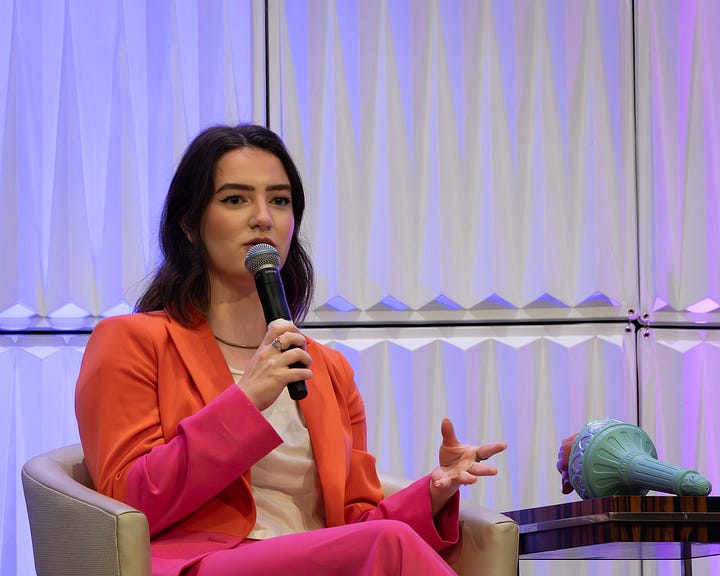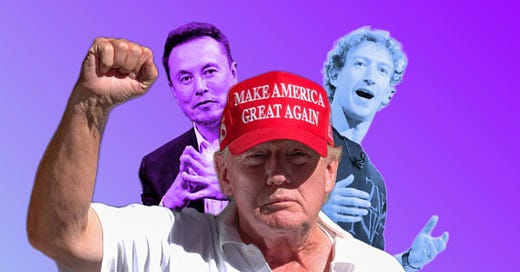Woke Or Not, Can We Talk About DEI, Politics, And Tech?
Platforms like Substack can help us better understand why Diversity, Equity, and Inclusion matter.
💬 Quick CONVERSATION STARTERS:
👏 Let’s start with this via
and 👏 LOVE IT!The conversation that Ramona started on Notes is a must-read!
Why do Diversity, Equity, and Inclusion matter?
We all need to have a conversation about DEI and what that acronym — sometimes overused, sometimes underestimated — means for all of us.
wrote in his “The thing about Trump's and MAGA's criticism of woke and DEI is there are probably valid arguments against both. But they are not making them.”, Executive Director of Black Leaders Organizing for Communities (BLOC), pointed out in : “It was never about DEI. DEI was only the crumbs they allowed us to have, while simultaneously undermining any advancement with harmful policies. Yes, we can be outraged at the messages the Trump administration is sending by doing mental gymnastics to find a way to further dehumanize and degrade our communities, and we can also say that DEI on its own is wholly ineffective to making a dent in oppressive systems.”Perhaps, it was time to have a debate on DEI. Perhaps, it was time to dig deep on why we, as a society, we need DEI programs — as well as lessons learned.
“The bottom line is this: True workplace equity can’t be achieved if we only advocate for some groups and not others,” wrote
in . “Supporting DEI efforts is about ensuring that everyone, parents, veterans, people with disabilities, racial minorities, and more have equal access to opportunities. When we fight for DEI, we’re not just helping others; we’re protecting the very policies that allow all of us to thrive.Enter Big Tech…
What seemed initially as a political-only debate, became a new trend in the private sector.
It started with the tech industry aligning right away with Trump:
In January, Mark Zuckerberg instructed Meta to kill all DEI efforts. “The legal and policy landscape surrounding diversity, equity and inclusion efforts in the United States is changing,” Janelle Gale, vice president of human resources at Meta, wrote in a memo. “The Supreme Court of the United States has recently made decisions signaling a shift in how courts will approach DEI. […] The term DEI has also become charged, in part because it is understood by some as a practice that suggests preferential treatment of some groups over others.”
Google said this month it was reevaluating its DEI programs “following recent court decisions and executive orders on this topic.” The company said it would no longer set hiring targets tied to improving diversity after previously setting a goal of increasing by 30% the proportion of “leadership representation of underrepresented groups” by 2025.
Amazon told its employees that it’s “winding down” certain programs after evaluating their “effectiveness, impact and ROI.”
But here’s the thing, not everybody in the private sector is aligning against DEI…
According to the Los Angeles Times, Apple is fighting back against anti-DEI proposals from conservative shareholders.
Netflix has remained committed to DEI after Trump’s executive order, stating in its annual report that a “major focus” is “fostering a work environment that is culturally diverse, inclusive and equitable.”
As
pointed out, “Global companies like JPMorgan Chase, Microsoft, Costco, e.l.f. Beauty, UBS, Unilever, and Toyota are reinforcing their commitment to DEI because they know it drives innovation, attracts top talent, and builds stronger businesses.”“Each year, The Microsoft Security Insights Show joins all of you to celebrate the achievements of women in cybersecurity and to underscore the importance of fostering diversity within this crucial field,”
, , , and wrote in .“Out of the world’s top tech companies, only two remain committed to promises made during the post-George Floyd-murder era: Microsoft and Netflix,” said
in .
DEI initiatives still matter, as
, , and explained in , where they analyses two different approaches: Target and Cotsco.The first received the most public backlash after they announced they were scaling back their DEI programs.
“To be clear, Target’s problem is not DEI. DEI is excellent for shareholders when executed as a strategy rather than reactionary,” Tanay, Stephanie, and Erika wrote. “Costco is a great example of this. Unlike Target, Costco has defended its DEI efforts, even in the face of political pushback.”
So, what now?
said it best in : “Now we have to ask: How can we keep DEI efforts moving forward against this kind of pushback? Maybe that means shifting the framing, doubling down on measurable impact, or embedding equity into broader organizational goals rather than branding it as a standalone initiative. I don’t know what the actual answer is, but I do know that the ‘meritocracy crisis’ being manufactured by opponents of DEI has nothing to do with the goals or virtues of DEI. It has everything to do with obfuscating the truth: that privileged people in this Country want things to stay pretty much the same.”Back to our series on digital trends in politics and diplomacy
We spoke to Katherine Bronov, Co-Executive Director at Women In Politics, for another installment of our politics and diplomacy series. Focus this time on GenZ, lifting woman’s voices, and predictions for 2025 and beyond.
The conversation with Katherine, which took place in January before Trump’s inauguration, is de-facto Part 9 of our series.
👏 Don’t miss 👏 Part 1 👏 Part 2 👏 Part 3 👏 Part 4 👏 Part 5 👏 Part 6 👏 Part 7 👏 Part 8. We’re extremely proud of this series!
Since the launch of our Substack
in late September 2024, we’ve been lucky. It was quite a treat to include in this series rockstar experts like , author of , Stefano De Cupis at the World Bank, , author of , Ryan Heath at Robin AI, political strategist and commentator , digital diplomacy expert , Ashwath Narayanan at Social Currant, Aleksandra Kuzmanovic at the World Health Organization (WHO), at Malala Fund, Aubrey Ottenstein at Hilltop, Valentina Tonutti of Fuori dal PED, communications strategist Dan Morrison, Patricia Gruver-Barr, digital diplomacy and social media expert Dante Licona, Erika Marzano at DW, Marco Ricorda, United Nations correspondent Stéphanie Fillion, tech and AI visionary Roxy Ndebumadu, Argentinian diplomat , Europe-based digital expert Anja Gabriel, and Italian entrepreneur extraordinaire Alessandro Tommasi, author of .Katherine Bronov: “the digital space provides unparalleled opportunities to amplify women’s voices”
1) How are Gen Z and young generations leveraging the digital space and social media in politics and diplomacy?
Gen Z has grown up using social media and the impact of their digital savvy on politics has never been more evident than in the past year. This was especially evident during the 2024 U.S. presidential election, which saw an unprecedented investment in digital platforms to engage young voters. Campaigns not only increased digital ads and posts but also collaborated with Gen Z content creators to amplify messaging and encourage political participation. Content creators have become ideal messengers and spokespeople for GenZ who increasingly receive their news from social media and non-traditional news sources. Another example is the role of social media in the Israel-Palestine conflict. While many remember college encampments across the U.S., fewer realize that much of the organizing and advocacy on both sides began online. Gen Z has transformed social media from a tool for connection into a powerful platform for education, organizing, and crowdsourcing information. From sharing memes to posting ‘get ready with me’ videos that incorporate political commentary, Gen Z continues to blur the lines between social media and political advocacy.


2) What are the main opportunities and the main challenges in lifting women's voices online?
One of the main challenges in lifting women’s voices online is that advocacy often emerges in response to crises rather than as a preventative measure. Historically, efforts to address systemic issues tend to gain traction only after a tragedy, and social media has amplified this pattern. Movements like #MeToo, the 2016 Women’s March, and responses to the reversal of Roe v. Wade were catalyzed by major events, making it difficult to sustain momentum when a cause isn’t at the forefront of the news cycle. Online attention spans are short, and advocacy struggles to compete for time and engagement, even with information readily available.
On the other hand, the digital space provides unparalleled opportunities to amplify women’s voices. Social media can unite people across geographic and cultural divides, enabling rapid dissemination of stories and calls to action. Viral hashtags, powerful storytelling, and community organizing online have proven successful in bringing attention to women’s issues and driving change. However, the challenge remains: how do we shift the narrative from reactive to proactive and ensure consistent investment in these causes beyond moments of crisis?
3) What are your digital and social media predictions for politics and diplomacy in 2025 and beyond?
There is a lot on my mind when it comes to the digital landscape as we move into 2025 and I expect social media to undergo some significant transformations this coming year. After a politically active year online ahead of a presidential election, several factors will shape the future: the debate over a potential TikTok ban, the rise of free speech absolutism, and the dynamics of a second Trump term.
While a TikTok ban appears unlikely, its survival will come with challenges. Similar to Twitter’s fragmentation after Elon Musk’s acquisition, TikTok could face internal divisions or external pressures, diminishing its once-unified presence. This fragmentation may further the partisan split in online platforms, with users gravitating toward spaces that align with their ideologies.
Additionally, I predict that a social media platform—whether existing or newly emerging—may gain official endorsement by the incoming administration (other than his own social media platform Truth Social). Such a move would blur the lines between government messaging and propaganda, raising concerns about censorship and eroding the ‘digital town square’ ideal that many platforms were originally built upon.
Overall, the future of digital and social media will likely be defined by increasing polarization, shifts in platform influence, and debates over the role of government and corporations in shaping the flow of information.





